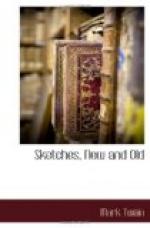tree, as far as his vision could reach. This
was surprising. Chief Engineer Spider ran aloft
and soon reported that these ropes were simply a web
hung thereby some colossal member of his own species,
for he could see its prey dangling here and there
from the strands, in the shape of mighty shreds and
rags that had a woven look about their texture and
were no doubt the discarded skins of prodigious insects
which had been caught and eaten. And then he
ran along one of the ropes to make a closer inspection,
but felt a smart sudden burn on the soles of his feet,
accompanied by a paralyzing shock, wherefore he let
go and swung himself to the earth by a thread of his
own spinning, and advised all to hurry at once to camp,
lest the monster should appear and get as much interested
in the savants as they were in him and his works.
So they departed with speed, making notes about the
gigantic web as they went. And that evening the
naturalist of the expedition built a beautiful model
of the colossal spider, having no need to see it in
order to do this, because he had picked up a fragment
of its vertebra by the tree, and so knew exactly what
the creature looked like and what its habits and its
preferences were by this simple evidence alone.
He built it with a tail, teeth, fourteen legs, and
a snout, and said it ate grass, cattle, pebbles, and
dirt with equal enthusiasm. This animal was regarded
as a very precious addition to science. It was
hoped a dead one might be found to stuff. Professor
Woodlouse thought that he and his brother scholars,
by lying hid and being quiet, might maybe catch a
live one. He was advised to try it. Which
was all the attention that was paid to his suggestion.
The conference ended with the naming the monster
after the naturalist, since he, after God, had created
it.
“And improved it, mayhap,” muttered the
Tumble-Bug, who was intruding again, according to
his idle custom and his unappeasable curiosity.
END OF PART FIRST
SOME LEARNED FABLES FOR GOOD OLD BOYS AND GIRLS
PART SECOND
HOW THE ANIMALS OF THE WOOD COMPLETED THEIR SCIENTIFIC LABORS
A week later the expedition camped in the midst of
a collection of wonderful curiosities. These
were a sort of vast caverns of stone that rose singly
and in bunches out of the plain by the side of the
river which they had first seen when they emerged
from the forest. These caverns stood in long,
straight rows on opposite sides of broad aisles that
were bordered with single ranks of trees. The
summit of each cavern sloped sharply both ways.
Several horizontal rows of great square holes, obstructed
by a thin, shiny, transparent substance, pierced the
frontage of each cavern. Inside were caverns
within caverns; and one might ascend and visit these
minor compartments by means of curious winding ways




